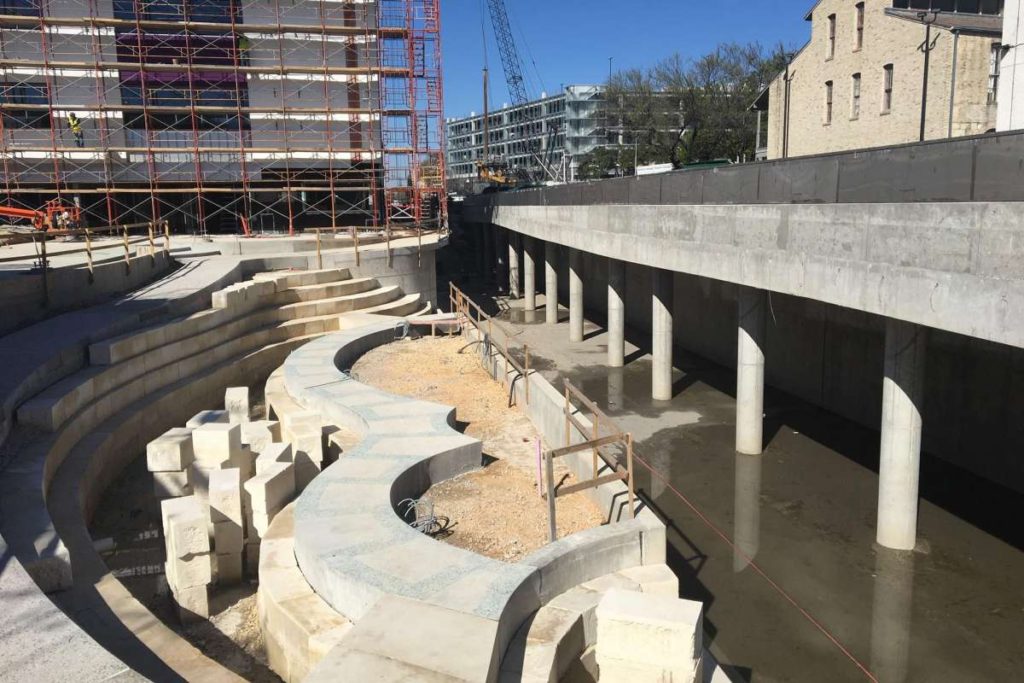Critical phase of San Pedro Creek project in downtown San Antonio more than halfway completed
Scott Huddleston. Feb. 14, 2020 Updated: Feb. 16, 2020 6:01 p.m.
With a critical phase of the San Pedro Creek improvement project more than halfway completed, officials Friday toured the three-block section under construction in a busy part of downtown.
“I’m really excited about this project that’s going to be done,” said U.S. Rep. Henry Cuellar, who was part of the group that donned hard hats to see the work going on from Houston Street to Nueva Street, near where the new federal courthouse also is going up.
Construction of the San Pedro Creek project’s Phase 1.2, the second improved segment of the creek, began in June 2018 and is set for completion by mid-2021. One of its showpiece elements is a 250-foot-wide, 15-foot-tall “water wall” feature with an interactive sound and light public art installation.
The outdoor plaza just south of Houston Street, across from the massive water wall feature, is the area most fully developed so far, with much of the concrete and stone already in place.

Bexar County Judge Nelson Wolff, who also was on the tour organized by the San Antonio River Authority, said a solid wall on the west side of the city-owned Spanish Governor’s Palace will be replaced with a wrought-iron fence, providing a view from the creek of the historic site’s lushly landscaped courtyard.
Wolff said the creek will be different from San Antonio’s famed River Walk, with wider sidewalks and vistas, less commercialization and more interpretive art, inscriptions and signs celebrating the community’s history as a Spanish-indigenous colonial village.
“It’s more up at ground level. It has a lot more landscaping to it. And so I think the stroll down the San Pedro Creek, when we get through, is an entirely different deal than the River Walk,” Wolff said.
The creek project seeks to provide an attractive space to complement public and private investment downtown, including a restored Alameda Theater, new offices and studios for Texas Public Radio and an expanded University of Texas at San Antonio Downtown Campus.
The old 1960s Bexar County Jail, long viewed as an eyesore, will be razed to make way for a new UTSA School of Business building.
In addition to touring the work in progress Friday, officials celebrated the final reimbursement of federal funds on a previous project that could help finish the creek overhaul and aid similar improvements on the West Side.
The county has secured the $26 million last reimbursement installment on the $61.3 million it advanced to improve the Mission Reach of the San Antonio River, completed seven years ago. The previous $35 million in reimbursements has been spent or programmed into the first four segments of the six-segment, 2.2-mile San Pedro Creek Culture Park.
Cuellar, D-Laredo, said a “very courageous county Commissioners Court trusted the federal government” when it committed in 2008 to cover part of the federal share of the $271 million, 8-mile Mission Reach on the South Side, the largest urban ecosystem restoration project in the country.
Cuellar, who represents a part of San Antonio, credited the city’s congressional delegation, the Army Corps of Engineers and the federal Office of Management and Budget with recognizing the county’s commitment to the river and creek projects and repaying the funds.
County Commissioner Justin Rodriguez, speaking at a news conference preceeding Friday’s tour, said the San Pedro Creek project will stimulate more economic investment downtown and, at its southern terminus near Interstate 35, connect with Apache Creek, one of three West Side Creeks that have been considered for similar improvements.
Local officials have said full reimbursement of funds for the Mission Reach allows them now to focus on seeking aid for the West Side creeks.
“When we talk about what that’s going to do, potentially, on ecosystem restoration, on flood control, to really renovate and bring life, invigorate the West Side, it’s going to make significant impacts,” Rodriguez said.
He said he hopes to achieve the goal of his predecessor, the late Commissioner Paul Elizondo, to finish the San Pedro Creek project and enhance its confluence with the Apache as “the gateway to the West Side.”
PRESS RELEASES
Categories
Archives
| M | T | W | T | F | S | S |
|---|---|---|---|---|---|---|
| 1 | 2 | |||||
| 3 | 4 | 5 | 6 | 7 | 8 | 9 |
| 10 | 11 | 12 | 13 | 14 | 15 | 16 |
| 17 | 18 | 19 | 20 | 21 | 22 | 23 |
| 24 | 25 | 26 | 27 | 28 | 29 | |